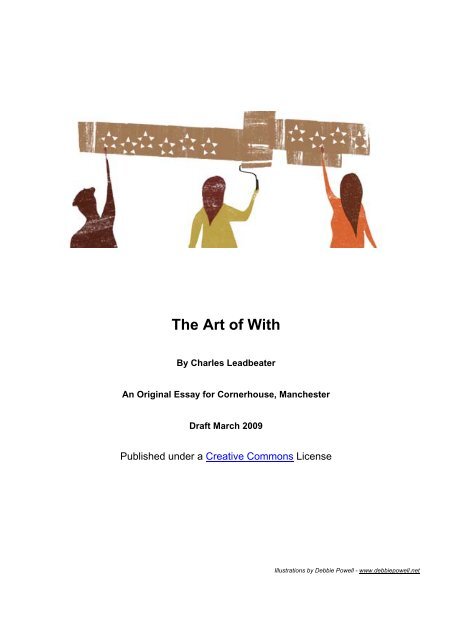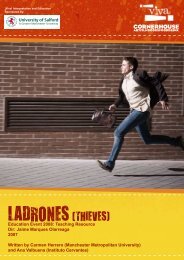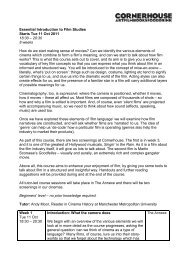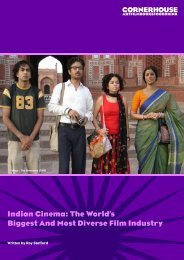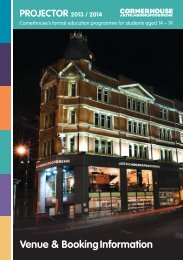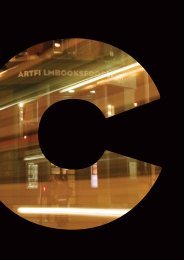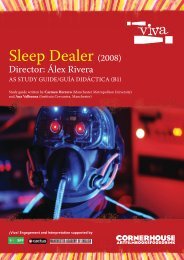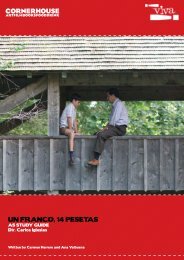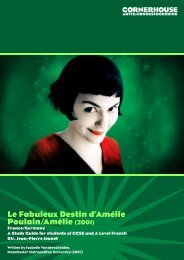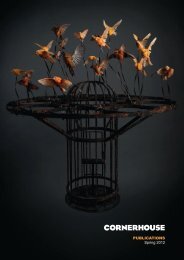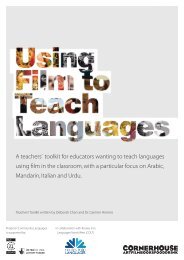The Art of With essay - Cornerhouse
The Art of With essay - Cornerhouse
The Art of With essay - Cornerhouse
You also want an ePaper? Increase the reach of your titles
YUMPU automatically turns print PDFs into web optimized ePapers that Google loves.
<strong>The</strong> <strong>Art</strong> <strong>of</strong> <strong>With</strong>By Charles LeadbeaterAn Original Essay for <strong>Cornerhouse</strong>, ManchesterDraft March 2009Published under a Creative Commons LicenseIllustrations by Debbie Powell - www.debbiepowell.net
I - <strong>The</strong> World <strong>of</strong> To and For<strong>The</strong> organisations and culture spawned by industrialisation, mass production and massconsumption in the 20 th century inescapably marked arts organisations, even as they stoodapart from and <strong>of</strong>ten in opposition to it. Put simply industrialisation created a world in whichgoods and services were delivered to and for people. For shorthand, call it the world <strong>of</strong> To andFor.Often in the name <strong>of</strong> doing things for people traditional, hierarchical organisations end up doingthings to people. Companies say they work for consumers but <strong>of</strong>ten treat them like targets to beaimed at, wallets to be emptied, desires to be excited and manipulated. <strong>The</strong> person who callshimself my “personal relationship manager” at a leading high street bank does not know mefrom Adam but in the cause <strong>of</strong> trying to sell me some savings products I do not want pretendsthat we are lifelong friends. In the name <strong>of</strong> doing something for me, actually he wanted to dosomething to me: relieve me <strong>of</strong> some money. Many experiences <strong>of</strong> public services are <strong>of</strong>tenlittle different. Social services departments were created to help people in need. Yet those onthe receiving end <strong>of</strong> services <strong>of</strong>ten complain they feel they are being done to, processed by abureaucratic machine.Politicians claim they are working for us, on our behalf, representing our views. But most <strong>of</strong> thetime they seem to be spinning messages at us.Our experience <strong>of</strong> things being done to us, in our best interests, starts early in life. All too <strong>of</strong>tenbeing at school, especially secondary schools, feels as if you are being done to: instruction isdelivered to you, as you listen to your teacher or copy from the blackboard. Secondaryeducation feels like something done to you too much <strong>of</strong> the time. Even in hospital when doctorsattend to you, it can feel as if you are being done to by a system that processes you even as itis responding to your most urgent needs.We live with systems that are meant to treat us like consumers or respond empathetically toour needs. All too <strong>of</strong>ten those very systems seem impersonal, rigid, inhuman even. Work inmany large organisations <strong>of</strong>ten feels like an imposition. Too much <strong>of</strong> management in largeorganisations feels like it is making people do things they do not really want to do.Of course we have benefited hugely as consumers from the growth <strong>of</strong> the To and For world witha vast range <strong>of</strong> mass produced goods and services delivered to us. <strong>The</strong>se common and2
widespread experiences <strong>of</strong> being done to and for stem from deeply rooted assumptions.Knowledge and learning flows from experts to people who are dependent or in need.Organisations are hierarchies based on the power and the knowledge to make decisions.Authority is exercised top down. <strong>The</strong> aim is to define what people lack – what they need or wantthat they have not got – and then deliver it to them. <strong>The</strong> world <strong>of</strong> To and For starts from peopleas bundles <strong>of</strong> needs, rather than, say, as bundles <strong>of</strong> capabilities and potential.<strong>The</strong> arts, and the modern avant garde in particular, has stood in opposition to this commodified,regimented world <strong>of</strong> to and for. <strong>The</strong> arts <strong>of</strong>fer a space for contemplation and reflection,challenge and controversy, higher meanings and deeper purpose. Yet in its way the modern artworld and modern arts institutions embody the principles <strong>of</strong> to and for just as powerfully as themodern factory or school.II- <strong>Art</strong> At Us<strong>The</strong> modern, iconoclastic avant garde starts from the idea <strong>of</strong> separation and specialism. Toproduce good art, artists have to separate themselves <strong>of</strong>f from the society around them –physically, emotionally, morally, socially – the artist as a self-styled resistance fighter pittedagainst the trivialising distractions <strong>of</strong> popular culture. <strong>The</strong> untrammelled imagination <strong>of</strong> the avantgarde artist is one <strong>of</strong> the last redoubts against bourgeoise, traditional, commodified culture. i<strong>Art</strong> should resist the familiar, banal and predictable. Good art must take a special,uncompromising vantage point, outside everyday society and refuse to be co-opted. As a resultmany people find modern art remote and impenetrable, perplexing and disturbing. <strong>The</strong>y aresupposed to. Modern art might spark controversy among the public but less <strong>of</strong>ten aconversation because art <strong>of</strong>ten uses a self-referential language that few people outside the artworld understand.In this account <strong>of</strong> art the meaning <strong>of</strong> a work <strong>of</strong> art is derived from the artist’s imagination,embodied in the work and then deposited, in a gallery or on a site, for the audience to withdrawmeaning from it. Imagine, make, deposit and let the audience withdraw: that’s the model <strong>of</strong>modern visual arts and its white cube galleries. Good art distinguishes itself from familiar andbanal popular culture because it does not make this process <strong>of</strong> withdrawal easy: it isambiguous, open to many different interpretations. <strong>Art</strong> should be unsettling and disturbing.Avant garde art is not designed to please or to soothe but to shock viewers out <strong>of</strong> complacentlyreceived ways <strong>of</strong> viewing the world. Avant garde art deliberately speaks to and <strong>of</strong>ten at people.3
Indeed many people feel they are being done to on a visit to a modern art gallery: confronted,shocked, disturbed. That’s the point. <strong>The</strong>y are not invited or allowed any return path for theirideas and views.This caricatured story nevertheless provides much <strong>of</strong> the script that people habitually follow asthey enter an arts space. It is a way <strong>of</strong> seeing our relationship to the gallery, the work and theartistic practice that created it. Implicit in this story is an account <strong>of</strong> the special training and selfbeliefthat artists must have to maintain a vantage point at odds with mainstream society. <strong>The</strong>production <strong>of</strong> their work <strong>of</strong>ten involves deploying those special talents in special places.Intermediaries, like curators and galleries, play a critical role in spotting and promoting thistalent. <strong>The</strong> gallery – or for that matter the concert hall – becomes a special zone in which itbecomes possible to see the world in a different way, to be raised up or deeply unsettled. <strong>The</strong>curator assembles the works for the audience, but the process through which that takes place,the knowledge employed, is as specialised and inaccessible as the knowledge <strong>of</strong> a consultantsurgeon. For many people, modern art seems to stand above them, looking down on them. <strong>The</strong>artist’s bravery in standing apart from the world, daring to see it in a different way, may betokena creative honesty and courage. But it could also be a marketing strategy to attract attention bybeing outrageous. <strong>The</strong> artist might have a special insight into the world he stands apart from.But just as <strong>of</strong>ten it seems modern artists are self-indulgently talking to a narrow coterie <strong>of</strong>followers.This avant-garde, the one that aims to shock us into seeing the world differently is a differentversion <strong>of</strong> the world <strong>of</strong> to and for. It is art done to us, as us and for us, but not with us.How will the spread <strong>of</strong> the web change the context for art, how it is produced, who is involvedand how people interact with it?<strong>The</strong> web is still in its infancy compared with the organisation and culture <strong>of</strong> mass industrialproduction and consumption. We are perhaps a decade into a process <strong>of</strong> development andpropagation that might take another forty or fifty years to fully unfold. <strong>The</strong> web could develop inseveral different, if not contradictory ways. People differ over how long and how big an impact itwill have: historians <strong>of</strong> technology warn that it <strong>of</strong>ten takes much longer for a technology tochange society than enthusiastic advocates assume. ii Critics argue the web will corrode muchthat is valuable in our culture – authority, manners, free thinking, quality, conversation.iii Libertarian and free market apostles believe the web will bring a cornucopia <strong>of</strong> choice anddiversity as more and more niche markets open up. iv Communitarians and one time leftists hope4
the web will finally deliver on <strong>of</strong>t disappointed hopes for more mutual, collaborative forms <strong>of</strong> selforganisation.v Some sage analysts warn that the web might yet prove to be its own worstenemy. As the viruses, spam and malware <strong>of</strong> the self-organising web proliferate so more peoplewill opt for closed gardens or even clouds run by large companies like Apple, Facebook orGoogle where people and privacy will be protected. viWhat follows does not explore all these alternatives. Instead the focus is on how thecollaborative potential <strong>of</strong> the web could inflect our culture, alter the way art is made and theroles <strong>of</strong> arts institutions, such as galleries.III - <strong>The</strong> Web: the Logic <strong>of</strong> <strong>With</strong>If the culture that the web is creating were to be reduced to a single, simple design principle itwould be the principle <strong>of</strong> <strong>With</strong>. <strong>The</strong> web invites us to think and act with people, rather than forthem, on their behalf or even doing things to them. <strong>The</strong> web is an invitation to connect withother people with whom we can share, exchange and create new knowledge and ideas througha process <strong>of</strong> structured lateral, free association <strong>of</strong> people and ideas. <strong>The</strong> principle underlyingthe web is the idea <strong>of</strong> endless, lateral connection.<strong>The</strong> rise <strong>of</strong> what has become known as Web 2.0 is based on a set <strong>of</strong> important changes inpeople’s relationship to information and to one another. Barriers to entry into creating mediacontent are falling. It is becoming easier and easier for people to create small packages <strong>of</strong>content, <strong>of</strong>ten by downloading tools available on the web. <strong>The</strong> web makes it easier for people topublish and distribute this content through a myriad <strong>of</strong> channels such as YouTube, Facebookand Slideshare. <strong>The</strong> flow <strong>of</strong> information is increasingly two way, with people able to commentback to and on what others have posted. It is also increasingly multilateral: the web allowspeople to make new lateral links to others, to share and connect. At its most impressive, atscale, these aspects <strong>of</strong> the web can be brought together in a process <strong>of</strong> highly collaborative,mass creativity in which large groups <strong>of</strong> people create, share, combine and collate content tocreate encyclopaedias, open source s<strong>of</strong>tware programmes, virtual worlds and games. <strong>The</strong> ethic<strong>of</strong> the Web 2.0 world is create, connect, combine and collaborate. <strong>The</strong> underlying principle <strong>of</strong>doing things with people rather than to or for them will breed very different organisations,services and experiences in virtually every field. In the media is it already creating a new sector- call it mutual media - in which large groups <strong>of</strong> people create content together, from NetMumsto Wikipedia, World <strong>of</strong> Warcraft to <strong>The</strong> Student Room.5
partnerships and collaborations not rigid, hierarchies. Authority, even at work, will need to beearned peer-to-peer. <strong>The</strong>re are many more points <strong>of</strong> where people can take initiative withoutwaiting for permission from on high. A with approach to any issue or challenge has to be coproducedand negotiated. That means it cannot be planned out in detail in advance. <strong>With</strong> stylecampaigns and organisations have to emerge and develop.<strong>The</strong> web is creating a culture more inclined to thinking, working, acting with providing analternative to the dominant principle <strong>of</strong> To and For. <strong>The</strong> principle <strong>of</strong> with can apply to art andculture as much as work, politics and learning. It would draw on a very different tradition <strong>of</strong> theavant-garde, one that has privileged participation and collaboration as the principles at the heart<strong>of</strong> modern art rather than shock and separation.IV- <strong>Art</strong> <strong>With</strong> People<strong>The</strong> 20 th century avant garde was built on the principle: separate and shock. <strong>The</strong> avant garde <strong>of</strong>the century to come will have as its principle: combine and connect. <strong>The</strong> web will encourage aculture in which art creates relationships and promotes interaction, encourages people to be apart <strong>of</strong> the work, if only in a small way.This “participatory” avant-garde will not emerged from thin air. It will be fed by the way the webgives new energy to participatory approaches to art, a digital version <strong>of</strong> a folk culture in whichauthorship is shared and cumulative rather than individualistic. vii <strong>The</strong> modern culture <strong>of</strong> postproduction,in which artists assemble their work using ingredients taken from other works, drawson this current. <strong>The</strong> artist becomes more like a DJ or a programmer, assembling a work frommodules already available. viii Umberto Eco long ago declared that works <strong>of</strong> art were open tomultiple interpretations; the reader was as active in creating meanings as the writer. ix Writing inthe 1930s Walter Benjamin praised art that invited participation: art was better the more itencouraged people to leave behind their passive role as spectator. x In the 1960s Guy Debordand the Situationist railed against the society <strong>of</strong> the spectacle, the empire <strong>of</strong> passive culture andin favour <strong>of</strong> art that activated its audience. xi Allan Kaprow became one <strong>of</strong> the best knownpractitioners <strong>of</strong> this philosophy with 1960s happenings – forerunners <strong>of</strong> flashmobs and alternatereality games - which were designed to bring art to life, to break down the barriers between theartist and the audience, art and the everyday. xii Public and community arts initiatives also havethis aim.What does this “participatory” avant garde stand for?7
<strong>Art</strong> is essentially inter-subjective and dialogic, and not just in the way an audience might receiveand interpret a work but in its constitution. Collaboration and participation is fundamental to thecreation <strong>of</strong> the art not just its presentation and reception. xiii<strong>The</strong> “participatory” avant-garde sees art as a kind <strong>of</strong> conversation, rather than a shock to thesystem. <strong>Art</strong> is not embodied in an object but lies in the encounter between the art and theaudience, and among the audience themselves. <strong>Art</strong> is not simply the result <strong>of</strong> self-expression bythe artists <strong>of</strong> a preconceived idea but the result <strong>of</strong> communication with the audience and otherpartners in the process. <strong>The</strong> artist’s role is not just to proclaim but to listen, interpret, incorporateideas and adjust. xiv<strong>The</strong> audience does not come to a gallery just to withdraw meaning from the art deposited therebut to be part <strong>of</strong> the art, so that their movements and reactions change what is going on. <strong>The</strong> artwraps them in. It is not just the artist’s ideas and knowledge that are on display but those <strong>of</strong> theparticipating audience as well.For the participatory avant-garde a work <strong>of</strong> art becomes more valuable the more it encouragespeople to join a conversation around it and to do something creative themselves. Participatoryart is based on constant feedback and interaction, people talking, arguing, debating around theart and their views having some impact.In this view <strong>of</strong> art, the role <strong>of</strong> the gallery or venue is not as a kind <strong>of</strong> artistic bank vault into whichthe work rich in meaning is deposited for safe keeping. An arts venue is a place that providesthe setting for creative interaction and communication. Indeed anywhere that makes that kind <strong>of</strong>creative interaction possible can become the site for a work <strong>of</strong> art. <strong>Art</strong> should not besequestered in special zones, where special people – the artists – deploy their special skills andexperience. Kaprow argued art should be grounded in the common experience <strong>of</strong> every day life.By its nature participatory art cannot be contained in the space demarcated by the artist and thegallery; it must be capable <strong>of</strong> expanding or dissipating to wherever the participants want to takeit. Participatory art cannot be pre-planned in every detail by the artist; otherwise it would be asham. It has to be free to emerge, adapt and grow wherever the participants want to take it. xv<strong>Art</strong> becomes more powerful the more connections it makes, rather than from standing alone,unyielding and beyond reach. In this world a curator becomes more like a convenor or mixer,creating a space in which the right kinds <strong>of</strong> conversations can take place.8
V- <strong>The</strong> Two Avant Gardes<strong>The</strong>se two stereotyped versions <strong>of</strong> what it means to be a modern, avant garde artist – theiconoclastic and the participatory - can easily be seen as at odds with one another, twoantagonistic poles.<strong>The</strong> iconoclastic, 20th century avant-garde aims to make people think about the world in newways by shocking them out <strong>of</strong> their established ways <strong>of</strong> seeing and thinking. <strong>The</strong> participatory21 st century avant-garde wants to achieve the same aim but through questioning andconversations, that make people acknowledge other vantage points, values, points <strong>of</strong> view.One privileges the special role <strong>of</strong> the artist standing outside society as the source <strong>of</strong> new andpotentially emancipatory insights and ideas that will appear shocking and disturbing. <strong>The</strong> othersees the salvation through communication and collaboration, art that unlocks our capacity forunderstanding one another, sharing ideas, finding communion through art. As a resultparticipatory and collaborative art may be more pragmatic because it is about establishing andcreating shared meanings rather than asserting a striking and controversial point <strong>of</strong> view fromon high.As Allan Kaprow put it long before the web emerged:“<strong>The</strong> root message <strong>of</strong> all artlike art is separateness and specialness; and thecorresponding one <strong>of</strong> all lifelike art is connectedness and wide angle awareness. <strong>Art</strong>like art’smessage is appropriately conveyed by the separate, bound “work”; the message <strong>of</strong> lifelike art isappropriately conveyed by a process <strong>of</strong> events that has no definite outline. ..<strong>Art</strong>like art sends itsmessage on a one-way street: from the artist to us. Lifelike art’s message is sent on a feedbackloop: from the artist to us and around again to the artist. You cannot talk back to and thuschange an artlike artwork; but conversation is the very means <strong>of</strong> lifelike art, which is alwayschanging.” xviThose who favour a more participatory and collaborative approach might dismiss theiconoclastic and individualistic avant-garde as superior, self-serving and alo<strong>of</strong>. <strong>Art</strong> is an oddlytruncated form <strong>of</strong> communications if it does not allow for feedback or reciprocity. Too <strong>of</strong>tenmodern art seems to be self-concerned. Participatory art prides itself on breaking down themystique and aura around art as a separate zone <strong>of</strong> activity and experience from life. xvii9
Yet participatory art is open to the charge that collaborative culture is just a recipe forconsensus and compromise. Collaborative working practices are increasingly common in thecommercial sphere; transplanting them into the world <strong>of</strong> art is not radical but simply mimics inart galleries what has been going on in the <strong>of</strong>fices <strong>of</strong> companies such as Google for years. Ourculture is becoming so soaked in the idea <strong>of</strong> collaboration that standing out against it might bemore radical than embracing the new conventional wisdom. Privileging collaboration at all costsrisks endorsing a fundamentalism about method. Good art can come from many differentsources and practices; collaboration is just one amongst many. If the point <strong>of</strong> art is to providethe setting for conversation then Starbucks could claim to be the world’s leading art business. xviiiBoth these approaches might give a role to new technology and the web.<strong>The</strong> traditional, iconoclastic avant-garde might see the web mainly as a tool to provide adifferent kind <strong>of</strong> interaction with the audience. <strong>The</strong> web might allow more people to gain moreaccess to the work, find out more about it. Video and other work might be distributed over theweb. <strong>The</strong> audience might be able to comment on work. <strong>The</strong> gallery or arts space would still belike a bank vault into which the work would be deposited, but the bank would acquire a webinterface for customers to use. xix Many arts organisations are developing more sophisticatedwebsites, with customer relationship management systems and using the web to distributecontent in new ways. New York’s Metropolitan Opera, for example, has begun to streamperformances to digital cinemas across Europe.<strong>The</strong> participatory avant-garde could make a far more powerful connection with the web’scollaborative and open source spirit. <strong>The</strong> web might open up who can contribute to the process<strong>of</strong> artistic creation, widen the definition <strong>of</strong> who is an artist. Some galleries have already begun toexperiment with content submitted by amateurs and outsiders. Open source approaches wouldgo even further, making the source code to work available – the notation – so anyone could useand reuse it. <strong>Art</strong> would be designed for adaptation and re-use. It would never be the finisheditem because someone might be adapting in some new way. Collaborative art <strong>of</strong> this kind wouldhave to be broken down into reusable modules, like Lego bricks, that users could play with.Online communities, like that those that have grown around Linux and Wikipedia, might play anew role in selecting art and deciding what should be shown. This kind <strong>of</strong> collaborative art mighttake place in many different settings, online and <strong>of</strong>fline, mimicking the hacklabs, meet ups andbar camps that have become the meeting places for the open source s<strong>of</strong>tware movement. xx Inthis world, the gallery would become more like a babbling souk or a forum, the setting forcultural collaboration and conversation on a scale so large that it cannot be planned out in10
advance.It is easy to see how elements <strong>of</strong> both these approaches might make sense for arts institutions.It is also easy to see how each could quickly lead to a dead end. In the first the web would belittle more than a different interface to a largely unchanged experience. In the secondcollaboration could all too easily become an end in itself rather than art. A more productive routewill be to explore a mix <strong>of</strong> the two. <strong>The</strong> starting point for that, as far as arts venues areconcerned if not artists, should be the experiences that people are looking for.VI - Enjoy, Talk, DoPeople are after a mix <strong>of</strong> three different experiences when they engage with media and culture.Some <strong>of</strong> the time people want to enjoy being entertained and served, to listen to a greatconcert, follow an intriguing lecture, watch a great film, read a good book, be inspired orunsettled by great art. For the sake <strong>of</strong> short hand call these Enjoy experiences. At their bestthey are engaging, intense and involving. <strong>The</strong>y make people think and feel strongly. <strong>The</strong>y arepassive only in the sense that people do not do much themselves other than watch, read listen.People do not push buttons or make their own contributions. But inside the audience’s head,imaginatively and intellectually, these enjoy experiences can be intensely engaging.<strong>The</strong>n there are experiences in which the content provides a focal point for socialising. <strong>The</strong> value<strong>of</strong> the content is amplified by the talking that goes on around. I watch football perhaps 90minutes a week but talk to people about it for at least twice that amount <strong>of</strong> time. Let’s call theseTalk experiences: the value lies in part in the talk the content sets <strong>of</strong>f.Finally, some people also want experiences that allow them to be creative. <strong>The</strong>y want to getinvolved, have a go, do their bit. This does not have to be high tech. My youngest son does thiswith a pen and paper on the kitchen floor. But he also uses Garage Band to make podcasts.Call these Do experiences.Most media and culture is a mix <strong>of</strong> Enjoy, Talk or Do. Galleries and museums provide a mix <strong>of</strong>Enjoy, Talk and Do. <strong>The</strong> experiences cannot be separated easily. People talk about films thatthey enjoy watching. <strong>The</strong> best trips to museums for young people involve searching and doing.For adults these trips <strong>of</strong>ten involve a trip to the café for a chat. Online mass computer games11
such as World <strong>of</strong> Warcraft are all about socialising and in social networking sites such asFacebook, socialising is the content. <strong>The</strong> lines between Enjoy, Talk and Do are not rigid.<strong>The</strong> web matters, however, because it is shifting the mix <strong>of</strong> Enjoy, Talk and Do available to mostpeople, especially the young. For my parents’ generation most media experiences were in theEnjoy category, with a limited amount <strong>of</strong> Talk and a tiny bit <strong>of</strong> Create. In their lifetime the maininnovations improved the quality <strong>of</strong> Enjoy – for example through the advent <strong>of</strong> colour and digitaltelevision. Till now, the main agenda for most media companies, museums and galleriesincluded, has been to improve enjoy experiences and make them available when and wherepeople want them.My nine year old son is looking for a completely different mix. He likes Enjoy experiences thatare engaging: the Simpsons, Harry Potter, Michael Morpurgo, Traces at Sadler’s Wells, But ifthe television, film or book he is looking at does not engage him then he is unforgiving. He is <strong>of</strong>fto do something more interesting that generally involves talking to his friends – in person,online, through Club Penguin, telephoning. Or he does something which can range frompainting a picture to making an animation or playing a game, in the garden or on Miniclip.For my parents Enjoy was the point <strong>of</strong> culture and it took up about 90% <strong>of</strong> their culturalexperience. For Ned and his generation Enjoy will be at most a third <strong>of</strong> their cultural life. Talkand Do will loom larger than it did for older generations. Ned’s generation are completelypragmatic about the kind <strong>of</strong> media they use to achieve their ends. <strong>The</strong>y regard the fiercedebates over the relationships between new and old, industrial and digital media as theological.Ned is very happy using very old media: he enjoys reading a good book; likes talking to his bestfriend who lives across the road; likes doing and creating, mostly by drawing with pencil andpaper. Ned is as at home using these very old media as he is using very new media <strong>of</strong> the web:he enjoys watching video on YouTube; likes socialising on Club Penguin or Bebo; createscontent using Garage Band. And he is not averse to using industrial era media – television, thetelephone, photographs.<strong>The</strong> web’s significance is not just that it allows new channels for people to download Enjoyexperiences – the BBC iPlayer phenomenon. <strong>The</strong> real significance is that it encourages peopleto adopt new habits and roles, as collaborators, distributors, editors and creators <strong>of</strong> content.<strong>The</strong>y want to connect with other people and do stuff together, at least some <strong>of</strong> them do, some <strong>of</strong>the time. Talk and Do will be much more intimately connected to Enjoy. Different sources <strong>of</strong>Enjoy experiences – book, theatre, television, video online – are in competition with one another12
as well as complementing one another. People watch the film <strong>of</strong> the book and then play thecomputer game. Different types <strong>of</strong> talk experiences – face-to-face, telephone, social media,tend to reinforce and complement one another, even more powerfully.<strong>The</strong> table below maps out the cultural and media space that Ned and his ilk graze througheveryday.It will be vital for arts venues to get the mix right. Only a small percentage <strong>of</strong> users <strong>of</strong> an artsinstitution will want to be participants – have real Do experiences - and even they will only wantto Do some <strong>of</strong> the time. People need easy to use tools, guidance and help to start contributing.Getting people involved is not always easy: they have to feel motivated; get feedback; find easyto use tools to allow them to take part; find people to do it with. Most collaboration, includingonline collaboration, builds around a core that has been put in place by a small group who havedone some <strong>of</strong> the heavy lifting. Conversations <strong>of</strong>ten start around objects or artefacts or events,rarely out <strong>of</strong> thin air. One <strong>of</strong> the reasons material objects are so important in people’s lives isthat they are reminders and bonds in relationships. Relationships <strong>of</strong>ten form around things: one<strong>of</strong> those things is art. How many people had their first date enjoying some kind <strong>of</strong> culturalexperience together, if only a trip to the pictures? xxi Conversation per se cannot be the definingfeature <strong>of</strong> arts organisations. C<strong>of</strong>fee shops are not art houses. <strong>The</strong> quality <strong>of</strong> the conversationthat takes place must matter: what it’s about, how it is conducted, what questions it poses. <strong>The</strong>web is <strong>of</strong>ten the setting for conversations among people <strong>of</strong> like mind or raucous argumentsamong strangers hiding behind the mask <strong>of</strong> anonymity. <strong>Art</strong> should provoke open and13
challenging conversations, with diverse and surprising contributors. xxii Across liberal societiestraditional sources <strong>of</strong> authority are more open to challenge and critique. Authority has to beexercised more openly and transparently. Yet there is still a critical role for skill and expertise todevise and curate engaging experiences. If connection and combination, collaboration andconversation are the watchwords <strong>of</strong> the new mass culture <strong>of</strong> the web, then arts institutions mustfind critical, imaginative, challenging ways to be open and collaborative and ways that producegood art.Being open and collaborative is not enough. It has to be done in a way that is engaging,challenging exciting, demanding. That means facing some <strong>of</strong> the dilemmas that come withbeing more “open”.VII - Is Open Always Better?Everyone seems interested in the idea <strong>of</strong> being more open, collaborative, from science toschools, political campaigns to companies, large established organisations to smaller start ups.All sorts <strong>of</strong> people are interested in models <strong>of</strong> organisation which have the followingcharacteristics:• Highly permissive forms <strong>of</strong> organisation, in which people do not have to ask permissionfrom controllers before they create content or get something done.• Very decentralised resources so initiative can come from many sources.• Sharing <strong>of</strong> information, ideas, peer to peer encouraged.• Pre planned structure is limited, much <strong>of</strong> structure emerges in action.Demand for these kinds <strong>of</strong> organisational approaches only likely to grow, thanks to shiftingvalues, the spread <strong>of</strong> technology and the downturn, which will reward stress on low cost models<strong>of</strong> organisation.Yet these open models seem quite fragile, especially outside s<strong>of</strong>tware. <strong>The</strong>re are someexcellent examples, principally Linux and Wikipedia. But there are also quite a lot <strong>of</strong> failedexperiments. <strong>The</strong>re is the distinct possibility that these open and collaborative models could beinspiring yet short lived, like so many failed experiments with mutualism and cooperation in thepast. Yet even as they remain fragile, open models are being taken up by commercialorganisations which want openness in some dimensions <strong>of</strong> what they do – they are more open14
to user generated ideas or to more open source styles <strong>of</strong> working. But they are not necessarilyopen to sharing their knowledge, intellectual property, assets or income.<strong>The</strong> key question for any organisation in future will be: what kinds <strong>of</strong> openness really count?First, who are we open to or with. Is it just a self appointed guild <strong>of</strong> geeks? <strong>The</strong> point <strong>of</strong> openknowledge is that is can be shared more easily. And sharing <strong>of</strong>ten spawns communities. But wealso know that these communities usually only work if they are structured. <strong>The</strong>y are not a freefor all. <strong>The</strong> kernel <strong>of</strong> Linux is not open to all to tamper with; it depends on your standing in thecommunity. <strong>The</strong> kernel is open in the sense that anyone can use it. Openness <strong>of</strong> use does notimply openness to all potential contributors. Openness may matter only in so far as it is a tool, ameans, to achieve something else, which is a new way for people to collaborate. Many <strong>of</strong> theclaims that the web is more open do not stand up to scrutiny. xxiiiSecond, what does it matter to be open about? An arts institution might for example be openabout its:• communication, using the web to communicate with new audiences in new ways;decision making, using the web to make decisions about what to put on shows about andwhat to include;• creativity, allowing more people to contribute to a show;• Resources, making the gallery and other resources available for those who want to usethem creatively.Openness in one dimension, communication say, may be compatible with closed andhierarchical forms <strong>of</strong> decision making about what should be shown. Open innovation comes inmany different forms. <strong>The</strong>re is open innovation into organisations– a wider funnel – so anorganisation can pull on more ideas from outside, especially from users and amateurcontributors, so called crowdsourcing. And there is open innovation out where organisationsgive out more <strong>of</strong> their knowledge for others to use and re-use, even if the original source <strong>of</strong> thisknowledge was experts working behind closed doors. Wikipedia and Linux are open in andopen out: they build up through open contributions and then make the results <strong>of</strong> that opencollaboration freely available to others. Many corporate open innovation projects are open in:they draw a wide range <strong>of</strong> ideas into a corporate innovation process that then exploits then in atraditional way. Dell’s Ideastorm which has several thousands <strong>of</strong> participants sits in this15
category. Some approaches – say in academia – are closed in the creation <strong>of</strong> knowledge butopen in its publication and access. Closed in, open out.Third, is how openness is made effective. One answer is that openness is all about knowledgeand information, so this is really a question <strong>of</strong> intellectual property and new open sourcelicensing etc. But <strong>of</strong>ten making a body <strong>of</strong> explicit knowledge, formally available is not enough tomake this openness effective, so that a wide range <strong>of</strong> people can really access it. <strong>The</strong>re is adifference between formal openness – the human genome is formally open to the public andeffective openness – people need special skills and tools to make sense <strong>of</strong> genomic data.Openness that can be effective might depend on providing people with tools so that can takepart, contribute, and re-use resources. And they might need support, for example from peersand a close community, to help them use these tools. Often that also means providing aplatform for cooperation.Even in corporate open innovation programmes users play quite different roles, from providingfeedback, modifying products, developing new products, with producers or independently. Anyarts organisation wanting to engage its audience to become participants and contributors wouldwant to experiment with a similarly wide range <strong>of</strong> potential roles. Many more are likely to providefeedback, than are likely to have the confidence to modify content, and they in turn willoutnumber those who want to create content from scratch.Fourth, and most importantly is the why question. Why do people contribute to open projects,freely reveal their knowledge and ideas to others and why should an arts organisation seek tobe open? When an organisation sets up a more open way <strong>of</strong> engaging with a community are itsmotives always the same as those <strong>of</strong> the outside contributors? One answer, the main one thusfar in open source style projects is that people are motivated by a non-monetary passion tocommit to a project. Open projects are sustained by a voluntary subsidy from user anddevelopers. It all comes down to love for what they are doing, the ProAm ethic. Participationcomes from intrinsic motivations and satisfactions, like the satisfaction <strong>of</strong> solving a puzzle. Aslightly different answer is that there is a currency in these communities but it is not money, thecurrency is recognition and appreciation. People contribute because they like getting a sense <strong>of</strong>recognition from a community <strong>of</strong> peers. It’s this external validation and recognition that matters.<strong>The</strong> motivation is still non-monetary but external. Finally, there are those who argue that moneydoes matter. People need to make a living somehow, even if they are contributing a lot to openprojects. <strong>The</strong>y still need to be able to put bread on the table. Some worry that money is a16
distortion <strong>of</strong> the purer motives that seem to underpin open projects. Others take a much morepragmatic view that they understand how to mix making money - for example by adapting opensource to particular markets and users – and contributing to open source projects. It’s not amatter <strong>of</strong> principle but a question <strong>of</strong> tactics.Openness is a matter <strong>of</strong> degree, just as participation is. <strong>The</strong>re are many different ways forpeople to collaborate, in many different kinds <strong>of</strong> activities, from fundraising, to feedback, toparticipation in a work. Organisations should engage in a portfolio <strong>of</strong> experiments each testingdifferent ways to engage participants in different kinds <strong>of</strong> projects. <strong>The</strong> space for these projectsis set out in the diagram below.VIII - Boulders and PebblesTwenty years ago the industries that provided most <strong>of</strong> our information, entertainment andculture resembled a few very large boulders strewn over an empty beach. <strong>The</strong>se boulders werethe big media companies that came into being because media had high fixed costs – printplants for newspapers and studios for television. <strong>The</strong>y were closely regulated and the resourcesthey used, like broadcast spectrum, were scarce. All that created high barriers to entry. <strong>The</strong>seboulders made their money mainly from advertising and by charging consumers for access totheir products, which required controlled access and <strong>of</strong>ten physical distribution and storage. <strong>The</strong>public cultural sector had its own equivalents <strong>of</strong> the boulders, built on scarcity <strong>of</strong> resources andaccess. <strong>The</strong> BBC, the British Library, the national museums, great pr<strong>of</strong>essional storehouses <strong>of</strong>17
culture and knowledge, are public sector boulders. xxivAnyone trying to set up a significant new media or cultural business could be seen coming froma long way <strong>of</strong>f. Rolling a new boulder onto the beach took lots <strong>of</strong> people, money and heavymachinery. In the mid-1980s an entrepreneur called Eddie Shah tried to roll a boulder onto theBritish beach by setting up a national newspaper based in northern England. That provoked aprotracted national strike. In the 1990s lottery funding allows the creation <strong>of</strong> a new generation<strong>of</strong> cultural boulders, many <strong>of</strong> them very attractive and successful. Some - the Sage inGateshead - had more open operating philosophies than their older brethren. Others simplyseemed to put the same cultural experiences in more attractive buildings. Until very recentlyboulders, both old and new, were the only business in town.Now imagine the scene on this beach in five years time. A few very big boulders will be stillshowing. But many will have been drowned by a rising tide <strong>of</strong> pebbles. Every minute millions <strong>of</strong>people come to the beach to drop their own little pebble: a blog post, a YouTube video, apicture on Flickr, an update on Twitter. A bewildering array <strong>of</strong> pebbles in different sizes, shapesand colours are being laid down the whole time, in no particular order, as people feel like it. xxvThis dangerously simplified division <strong>of</strong> the world into boulders and pebbles means there will bethree kinds <strong>of</strong> media and cultural businesses in future.All the new media and cultural organizations, created from now on, will be pebble businesses.Google and other more intelligent search engines <strong>of</strong>fer to help us find just the pebble we arelooking for. Google will increasingly <strong>of</strong>fer to organize more and more <strong>of</strong> the unruly beach.Wikipedia is a vast collection <strong>of</strong> factual pebbles. YouTube is a collection <strong>of</strong> video pebbles; Flickr<strong>of</strong> photographic pebbles. Social networking sites such as Facebook allow us to connect withpebbles who are friends. Twitter, the micro blogging, service allows people to create collections<strong>of</strong> lots <strong>of</strong> really tiny little pebbles. Most cultural entrepreneurs seeking to set up a creative newbusiness in future will start among the pebbles and aim to spread. xxvi<strong>The</strong>re will still be lots <strong>of</strong> activity in the boulder business. Many <strong>of</strong> the boulders will have to mergeand cut costs to withstand the onslaught <strong>of</strong> the pebbles. Channel 4 might merge with the BBCWorldwide. <strong>The</strong> regional newspaper industry is already lobbying to make it easier for mergersarguing it is the only way to stave <strong>of</strong>f the industry’s collapse. <strong>The</strong> national newspaper industry iscutting jobs. <strong>The</strong> cultural sector may well face similar pressures, to merge to cut costs. Only thebig will really do well in this game.18
<strong>The</strong> main growth area, however, for the cultural sector, will be in hybrids: boulders that findways to work with the pebbles or pebble that grow to be boulders. Barack Obama made it to theWhite House thanks to a campaign which took organizing the pebbles to new heights. Obama’sweb based campaign rewrote the rules on how to reach voters, raise money, organisesupporters, manage the media and wage political attacks. Obama is now a boulder that speakspebble. <strong>The</strong>re are huge opportunities to create more hybrids like this, as large institutions seekto engage with their communities in new ways and self-organising communities go in the otherdirection, acquiring scale. A prime example is the way the British Library is trying to keep upwith the online revolution going on around it. Many public institutions – the BBC, the NHS – arenow entering this space. <strong>The</strong> web could allow us, at quite low cost, to create an entire newgeneration <strong>of</strong> public service media organisations simply by encouraging publicly fundedmuseums and galleries to become multi-media, running their own television channels over theweb or finding new ways to engage audiences to become collaborators and contributors.Those are the strategic choices facing all cultural and media organizations, including those inthe publicly funded sector. Start from scratch with the pebbles. Build a bigger, stronger boulder.Build a hybrid that is a mix <strong>of</strong> boulder and pebble.Many arts organisations will want to see themselves in the middle ground: retaining theirboulder status but finding interesting ways to interact with the pebbles. Most <strong>of</strong> these will seethis task <strong>of</strong> interacting with the pebbles as mainly about marshalling the web and digitaltechnology to allow them to do the job they already do a bit better: online booking; seeingpreview video clips; blogging; building a social media pr<strong>of</strong>ile; creating new ways for customersto interact with their institution.None <strong>of</strong> that is easy nor to be dismissed lightly. Using web technology well to interact withaudiences takes time, persistence, money, imagination and skill. However the web’s potential tochange how we make and experience culture will be fully opened up only if we go further.It would be naive for an arts organisation to endorse a shift towards collaboration andparticipation as always and essentially good. It depends how it is done, on what terms, in whoseinterests. As the web spreads it will slowly yet thoroughly change our sense <strong>of</strong> ourselves: howwe experience and create culture; how we get ourselves organised and get jobs done; how wemake decisions and find knowledge. <strong>Art</strong>s organisations should critically and creatively engagewith this culture, exploring, probing, questioning, challenging it, opening up possibilities within it19
that commerce will not entertain, provoking people to see it in different lights and ways. In theprocess artists and the communities they engage will open up new ways <strong>of</strong> seeing an emergentmass culture which will be as saturated with the idea <strong>of</strong> collaboration as industrial culture is withthe idea <strong>of</strong> consumption. Many are already exploring this space. Martin Creed’s Work 850 atTate Britain had members <strong>of</strong> the public sprinting through the gallery, weaving their way betweenvisitors. Janet Frere’s work Return <strong>of</strong> the Soul was created with thousands <strong>of</strong> Palestinianrefugees making tiny clay figures. Anthony Gormley is experimenting with structured massparticipation in One & Another, his plan to create a living monument on the 4 th Plinth in TrafalgarSquare, with a cast <strong>of</strong> 2,400 members <strong>of</strong> the public occupying the plinth for an hour each over100 days. Mass participation is a theme in Olafur Eliason’s work such as the Weather Project inTate Modern in 2003 and has figured in the work <strong>of</strong> <strong>Art</strong> Angel, for example, through the massreconstruction <strong>of</strong> the siege <strong>of</strong> Orgreave during the miner’s strike.If artists can work in the right way to work with these communities they will find new, morecollaborative and participatory ways, to make good art. Engaging with the art <strong>of</strong> with isinescapable and unavoidable. But it needs to be done well, intelligently, thoughtfully, testing thelimits <strong>of</strong> collaboration rather than simply celebrating it. Better get on with it.20
Footnotesi Grant Kester Conversation Pieces: Community and Communication in Modern <strong>Art</strong>, University <strong>of</strong> California Press, 2004ii David Egerton, <strong>The</strong> Shock <strong>of</strong> the Old, Pr<strong>of</strong>ile 2006iii Andrew Keen <strong>The</strong> Cult <strong>of</strong> Amateur, Nicholas Brearley, 2007; Nicholas Carr <strong>The</strong> Big Switch, Norton, 2008iv Chris Anderson, <strong>The</strong> Long Tail, Random House, 2007v Pekka Himanen et al <strong>The</strong> Hacker Ethic Random House, 2000; Yochai Benkler <strong>The</strong> Wealth <strong>of</strong> Networks, Yale UniversityPress, November 2007vi Jonathan Zittrain, <strong>The</strong> Future <strong>of</strong> the Internet and How to Stop It, Allen Lane, 2008vii Charles Leadbeater, We Think Pr<strong>of</strong>ile 2008viii Nicholas Bourriaud Postproduction: Culture as Screenplay: How <strong>Art</strong> Reprograms the World, Lukas and Sternberg, 2005x Charles Leadbeater, We Think Pr<strong>of</strong>ile 2008xi Guy Debord, Society <strong>of</strong> the Spectacle, Black and Red, 1984xii Allan Kaprow and Jeff Kelley, Essays on the Blurring <strong>of</strong> <strong>Art</strong> and Life, University <strong>of</strong> California Press, 1996xiii Grant Kester, Conversation Pieces, Nicholas Bourriaud, Relational Aesthetics Les Presse Du Reel,France (1 Jan 1998)xiv Claire Bishop, Participation Whitechapel <strong>Art</strong> Gallery 2006xv Kaprow and Kelley, Blurring <strong>Art</strong> and Lifexvi Kaprow and Kelley, Blurring <strong>Art</strong> and Lifexvii Bourriaud, Relational Aesheticsxviii Claire Bishop Antagonism and Relationship Aesthetics, OCTOBER 110, Fall 2004, pp. 51–79. © 2004 October Magazine,Ltd. and Massachusetts Institute <strong>of</strong> Technology.xix Nina Simon’s blog Museum 2.0 provides one <strong>of</strong> the most useful guides to the way museums and galleries are responding tothe web. http://www.museumtwo.blogspot.com/site etcxx Simon Yuill All Problems <strong>of</strong> Notation Will be Solved by <strong>The</strong> Masses, Mute February 2008xxi Daniel Miller, <strong>The</strong> Comfort <strong>of</strong> Things, Polity Press, May 2008xxii Bishop Antagonism and Relational Aestheticsxxiii Matthew Hindman, <strong>The</strong> Myth <strong>of</strong> Digital Democracy, Pirnceton University Press 2008xxiv Charles Leadbeater, We Thinkxxv Clay Shirky, Here Comes Everybody, Penguin 2008.xxvi Henry Jenkins, Convergence Culture New York University Press, 200621


